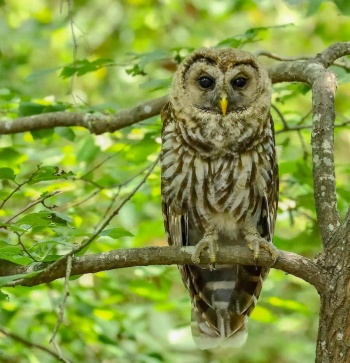BigRedBirder (talk | contribs) (→Voice) |
(→External Links: improved GSearch; GS checked 1) |
||
| (19 intermediate revisions by 10 users not shown) | |||
| Line 1: | Line 1: | ||
| − | + | [[Image:Barred_Owl.jpg|thumb|450px|right|Photo by {{user|David+Roach|David Roach}} <br />[[Corkscrew Swamp Sanctuary]], [[Florida]]]] | |
| − | [[Image:Barred_Owl.jpg|thumb| | + | ;[[:Category:Strix|Strix]] varia |
| + | |||
==Identification== | ==Identification== | ||
| − | == | + | *Length 48-51 cm, wingspan 107-111 cm, weight 630-800 g |
| − | A series of | + | *Adult shows pale face, dark rings around the eyes, yellow beak, brown eyes, no ear tufts, upper parts mottled grey-brown, light underparts with dark markings which are mainly vertical, legs and feet covered in feathers up to the talons. |
| + | *Fledglings are downy like in most owls; older fledglings shows horizontal markings on breast, opposite of what is shown in adults. | ||
| + | ==Distribution== | ||
| + | Resident from [[Minnesota]] south to eastern [[Texas]] and east to [[New Brunswick]] and [[Nova Scotia]] south to [[Florida]]. Also in central [[Canada]] west to [[British Columbia]] and in northern [[Washington]] and [[Idaho]]. | ||
| + | [[Image:Barred_Owl_Fledging_25May07.jpg|thumb|350px|right|Fledgling <br />Photo by {{user|GaryT|GaryT}} <br />Hills Creek State Park, Tioga County, [[Pennsylvania]], May 2007]] | ||
| + | ==Taxonomy== | ||
| + | [[Cinereous Owl]] was formerly included in this species. | ||
| + | ====Subspecies==== | ||
| + | Polytypic. Three subspecies are recognized<sup>[[#References|[1]]]</sup>: | ||
| + | *''S. v. varia'': | ||
| + | :*South-eastern [[Alaska]] to south-eastern [[Canada]] and east-central [[US]] | ||
| + | *''S. v. georgica'': | ||
| + | :*South-eastern [[US]] ([[Arkansas]] to eastern [[Texas]], the Gulf Coast and southern [[Florida]]) | ||
| + | *''S. v. helveola'': | ||
| + | :*South-central [[Texas]] | ||
| + | |||
| + | ==Habitat== | ||
| + | Forests or suburban areas. | ||
| + | ==Behaviour== | ||
| + | [[Image:BAOW 3a GibTwp 7 01 08.jpg|thumb|350px|right|Photo by {{user|DougLaslj|DougLaslj}}<br />Gibson Township, [[Michigan]], July 2008]] | ||
| + | ====Breeding==== | ||
| + | They nest in a tree cavity; 2 to 4 eggs are laid and incubated by the female for about 4 weeks. The young fledge after a further four to five weeks. | ||
| + | ====Diet==== | ||
| + | The diet includes mainly mice, but also rabbits, chipmunks, foxes, opossums, birds such as grouse and doves. | ||
| + | ====Vocalisation==== | ||
| + | A series of deep hoots that sound very similar to ''Who cooks for you? Who cooks for you, all?''<br /> | ||
Young birds give a loud shrieking | Young birds give a loud shrieking | ||
| + | ==References== | ||
| + | [[Image:Barred Owl 4 Camelot Park.jpg|thumb|350px|right|Juvenile<br />Photo © by {{user|Stanley+Jones|Stanley Jones}}<br />Camelot Park, Bryan, Brazos County, [[Texas]], [[USA]], June 2020]] | ||
| + | #{{Ref-Clements6thAug21}}#{{Ref-GillDonsker17V7.3}}#König, C. and F. Weick 2008. Owls of the World, second edition. Christopher Helm, London. ISBN 978-0-7136-6548-2 | ||
| + | #Howell & Webb, 1995. A guide to the birds of Mexico and northern Central America. Oxford University Press. ISBN 0198540124 | ||
| + | {{ref}} | ||
| + | ==External Links== | ||
| + | {{GSearch|"Strix varia" {{!}} "Barred Owl"}} | ||
| + | {{GS-checked}}1 | ||
| + | <br /> | ||
| + | <br /> | ||
| − | + | [[Category:Birds]][[Category:Strix]] | |
| − | |||
| − | [[Category:Birds]] | ||
Latest revision as of 14:41, 15 December 2023
- Strix varia
Identification
- Length 48-51 cm, wingspan 107-111 cm, weight 630-800 g
- Adult shows pale face, dark rings around the eyes, yellow beak, brown eyes, no ear tufts, upper parts mottled grey-brown, light underparts with dark markings which are mainly vertical, legs and feet covered in feathers up to the talons.
- Fledglings are downy like in most owls; older fledglings shows horizontal markings on breast, opposite of what is shown in adults.
Distribution
Resident from Minnesota south to eastern Texas and east to New Brunswick and Nova Scotia south to Florida. Also in central Canada west to British Columbia and in northern Washington and Idaho.
Taxonomy
Cinereous Owl was formerly included in this species.
Subspecies
Polytypic. Three subspecies are recognized[1]:
- S. v. varia:
- S. v. georgica:
- S. v. helveola:
- South-central Texas
Habitat
Forests or suburban areas.
Behaviour
Breeding
They nest in a tree cavity; 2 to 4 eggs are laid and incubated by the female for about 4 weeks. The young fledge after a further four to five weeks.
Diet
The diet includes mainly mice, but also rabbits, chipmunks, foxes, opossums, birds such as grouse and doves.
Vocalisation
A series of deep hoots that sound very similar to Who cooks for you? Who cooks for you, all?
Young birds give a loud shrieking
References
- Clements, J. F., T. S. Schulenberg, M. J. Iliff, S. M. Billerman, T. A. Fredericks, J. A. Gerbracht, D. Lepage, B. L. Sullivan, and C. L. Wood. 2021. The eBird/Clements checklist of Birds of the World: v2021. Downloaded from https://www.birds.cornell.edu/clementschecklist/download/
- Gill, F. and Donsker, D. (Eds). 2017. IOC World Bird Names (version 7.3). Available at http://www.worldbirdnames.org/.
- König, C. and F. Weick 2008. Owls of the World, second edition. Christopher Helm, London. ISBN 978-0-7136-6548-2
- Howell & Webb, 1995. A guide to the birds of Mexico and northern Central America. Oxford University Press. ISBN 0198540124
Recommended Citation
- BirdForum Opus contributors. (2025) Barred Owl. In: BirdForum, the forum for wild birds and birding. Retrieved 5 January 2025 from https://www.birdforum.net/opus/Barred_Owl
External Links
GSearch checked for 2020 platform.1







